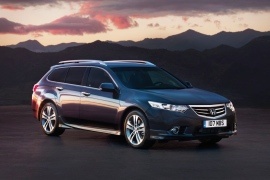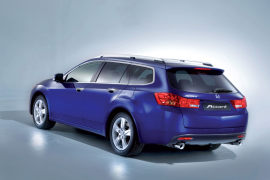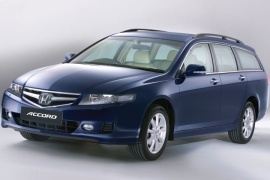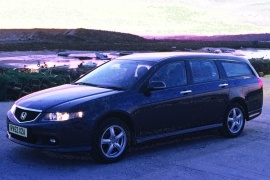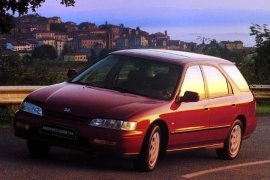HONDA Accord Tourer Models/Series Timeline, Specifications & Photos
First production year: 1993
Engines: Diesel, Gasoline
Body style: Wagon (station wagon, estate, combi, touring)
The eighth generation of the Accord Tourer (station-wagon) was unveiled at the Geneva Motor Show. Its sedan sibling was already on the market for a few years.
It was the last generation officially sold on European soil. While its predecessors were nimble and fast, the eighth generation of the Accord Tourer was built for comfort. But unlike its predecessor, the design team took a long time to draw it and it was a more pleasant view.
From the outside, up to the B-pillar, it was the same vehicle as to the sedan. From there on, the body was different. It featured a longer roof and different rear doors. Behind the last row, there was another side window. The back with the tailgate was raked and tried to look more aerodynamic. A small roof-spoiler was placed on top of the rear windscreen.
Inside, there was the same interior for the front, with the large and comfortable seats. There was an extra button to power-open the tailgate when it was fitted. The rear seats offered more headroom than the sedan, but it was enough for tall passengers. The seatbacks were folding in a split 60:40 way.
The Accord had a strong engine lineup consisted of three units: two gasoline units and a diesel. All models were fitted with a standard 6-speed manual, and both gasoline units were available with a 5-speed automatic.
When Honda introduced the eighth generation of the Accord in Europe, it didn't know that it won't last for too long, so it built it right.
If it wasn't for the world financial crisis, maybe Honda could have kept the Accord and the Accord Tourer on the European market. But it couldn't. The lack of engine range and some other sophisticated features led to slow sales and, eventually, to drop out of the market just three years later.
Honda already made a European-spec Accord and tuned it for the local roads. Its look was also on par with other carmakers. Its mix o sharp angles and curved surfaces were a lesson well-learned about the new-edge design trend. Its headlights, angular and swept-back on the sides, the shield-like shape of the grille, and the sporty-looking front apron were right on the money for the European customers. On its sides, the eighth Accord Tourer finally found its proper shape, with a hatchback-style tailgate.
Its interior was vast and comfortable. It could fit five adults without any problem. In the back, the split-folding bench was there to expand the trunk from 459 liters (16.2 cu-ft) to a better 1,183 liters (41.8 cu-ft). There were compact station wagons that could do better than that.
Honda's biggest problem was with the engines. While all of them were Euro 5 compliant, there were only three of them and only one turbo-diesel unit. Moreover, even if it was an awarded engine, that turbo-diesel exceeded the 2.0-liter tax class, while Ford, Opel/Vauxhall, Renault, and Volkswagen featured under 2.0-liter engines with similar power.
The European Honda Accord received a facelifted version in 2005 along with the rest of the range and improved fuel-efficiency for specific versions.
The Accord Tourer was already famous thanks to its power-tailgate system, which was not so common back in 2005. Honda considered that it has to give some perks to the Accord's station wagon version to compensate for the exterior look, which was far from winning any design contest.
The 2006 model featured a new front fascia, with a horizontal chromed slat across its grille. Honda designers reshaped the front bumper, adding outer side air-intakes, and moved the fog-lights moved toward the center. Depending on the trim level, the Accord Tourer sported extended rocker panels and a roof-spoiler on top of the tailgate. The roof-rails were also on the options list.
Inside, the carmaker made some changes on the center stack and inside the instrument cluster. It replaced the red lettering with white and blue ones to calm down the heavy-footed drivers. Like its predecessor, it offered the car in three trim levels: elegance, comfort, and executive. The only three options available were the sunroof, navigation system, and, depending on the engine, the automatic gearbox. Its trunk was still among the best in its class. With all the seats in place, could get up to 575 liters (20.3), while with the entire split-folding rear bench folded, space increased to 1,707 liters (60.3 cu-ft)
For the facelifted version, Honda introduced a six-speed manual gearbox for the 2.0-liter gasoline and for the 2.2-liter turbo-diesel engines. That brought better fuel efficiency on the highway.
HONDA Accord Tourer 2.0L i-VTEC 5AT FWD (155 HP)
HONDA Accord Tourer 2.0L i-VTEC 5MT FWD (155 HP)
HONDA Accord Tourer 2.4 i-VTEC 5AT FWD (200 HP)
HONDA Accord Tourer 2.4L i-VTEC 5AT AWD (160 HP)
HONDA Accord Tourer 2.4L i-VTEC 5AT FWD (160 HP)
The seventh generation of the Accord was available in Europe as a sedan and station wagon, the latter being named tourer.
The Accord Tourer was introduced a year after the sedan version, and its features were unexpected in its segment. Its main problem was that it was not offered with a wide range of engines and the automatic transmission was slow.
The sharp nose design with angry-looking headlights was one of the best-designed parts of the car. Up to the B-pillar, it had the same form as the sedan version, but there was a different vehicle from there. In their quest to built a roomy interior, the Japanese designers made the tailgate almost vertical, but it was very practical since it was fitted with electric opening and closing, a feature that was uncommon for its segment.
The interior was similar to the rest of the range, with a simple dashboard design. It was offered in a few trim levels, and only the top, Executive, version was available with a sat-nav system and sunroof. The rear seat backseat was folding in a 40/60 ratio to expand the trunk space and formed a flat floor from bumper to the front seats.
Under the hood, the Accord was available with only three engine options: 2.0-liter gasoline, 2.4-liter gasoline, and a 2.2-liter turbodiesel. The automatic gearbox was available only for the former ones. The latter was paired exclusively with a 5-speed manual gearbox until the 2005 facelift.
HONDA Accord Tourer 2.0L i-VTEC 5AT FWD (155 HP)
HONDA Accord Tourer 2.0L i-VTEC 5MT FWD (155 HP)
HONDA Accord Tourer 2.4L 5AT AWD (160 HP)
HONDA Accord Tourer 2.4L 5AT FWD (160 HP)
HONDA Accord Tourer 2.4L i-VTEC 5AT FWD (190 HP)
HONDA Accord Tourer 2.4L i-VTEC 6MT FWD (190 HP)
Honda introduced the fifth generation of the Accord for the European market in 1993 as a sedan, followed by a station wagon version, traditionally named the Aerodeck.
While Audi had the Avant and BMW had the Touring, Honda chose an unusual moniker for the Accord Station wagon: the Aerodeck. Customers had expected this version since the previous two generations also had it. However, since the fifth generation of the Accord was the longest in its family, the Aerodeck provided so much interior space that it made some MPVs redundant. At the same time, since it relied on the same platform as the fourth generation of the Accord, it had the front and rear overhangs significantly longer. Furthermore, the car had a lower tailgate opening height than its sedan sibling, so customers could load or unload the vehicle more easily.
The 1994 Honda Accord Aerodeck featured narrow headlights with integrated turn signal lamps on the outer sides and slightly narrower ones on the inner area. They looked sharp and were still angular. Below them, the automaker installed a wrapped-around plastic bumper that housed an air intake in the apron flanked on the sides by a pair of scoops. This secondary air intake was needed since the main grille was narrow and couldn’t supply enough cold air to the radiators.
From its profile up to the B-posts, the 1994 Honda Accord Aerodeck shared its parts with its sedan sibling, but it differed behind those. It featured new doors and a third row of windows placed between the C-pillars and the rearmost posts. The tailgate was raked forward to enhance the vehicle’s look and was flanked by corner-mounted taillights carried over from the sedan version. Honda also offered the car with a choice of steel or alloy wheels, depending on the grade. A sunroof was available at extra cost, while the antenna was placed at the back of the roof, above the tailgate.
Inside, the vast cabin could easily accommodate five people. Those from the front enjoyed the visibility of a rounded-shaped dashboard. Fronting the driver was a rounded instrument cluster with a new layout. It featured large dials for the tachometer and speedometer that were flanked on their outer areas by the water temperature on the left and the fuel level gauges on the right, respectively. Honda installed comfortable bucket seats with mild bolstering at the front, separated by a center console that housed the gear selector, an armrest with a storage area underneath, and the buttons for the power windows. In the back, the flat-folding bench seat could expand the loading space and provide a long enough platform, which converted the vehicle into a camper where a six-footer (2 m) person could sleep well enough.
Under the hood, the European-spec Accord carried over the same F-family engines as its predecessor, although it improved. These were mated with five-speed manual gearboxes, while a four-speed automatic was available for selected versions. The Accord CC7 was the first to get a VTEC engine. Since the car shared its underpinnings with the previous generation (the CB3), it featured multi-link suspension in all corners.
